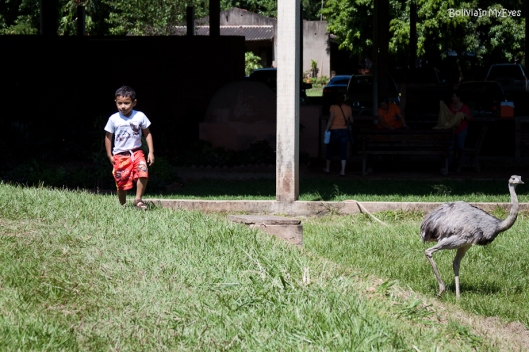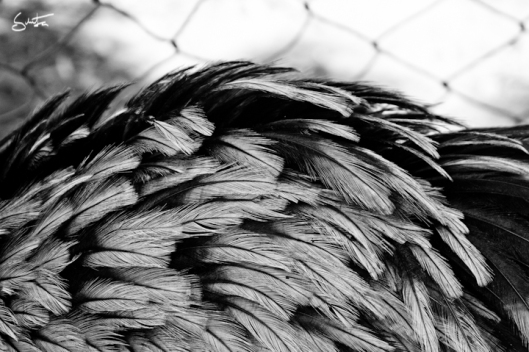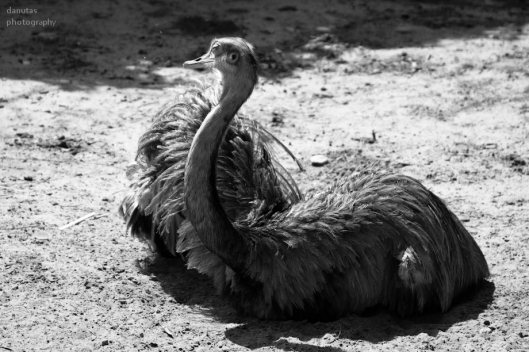Gastronomia najwyzszych regionow Boliwii jest mieszanka receptur pre-kolumbijskich, kolonialnych oraz wspolczesnych, zas krolem produktow spozywczych, w departamentach La Paz, Oruro i Potosi, jest ziemniak (la papa). W Boliwii, kolebce tego warzywa, produkuje sie ponad 200 roznych gatunkow ziemniaka, choc znanych jest 5000 odmian, o roznych rozmiarach, ksztaltach, kolorach, teksturze i smakach! Jedna z anegdot Andyjskich glosi, ze pewna grudkowana odmiane ziemniaka, chula, wykorzystuje sie w testowaniu gotowosci kobiety do zamazpojscia – jezeli dziewczyna dobrze obierze ziemniaka, to bedzie dobra zona.
Traditional cuisine of the highest regions of Bolivia, is a mix of pre- Columbian, colonial and contemporary recipes and the king of all food, in the departments of La Paz, Oruro and Potosi is potato (la papa). Bolivia , the original cradle of this vegetable, produces more than 200 different species of potato, although around 5,000 varieties of different sizes, shapes, colors, textures and flavors are known ! One of the Andean anecdotes says that one of the more lumpy potatoes, chula , is used in testing if the girls are ready to get married – if the girl will peel potatoes well, it means that she will be a good wife.

Fot. kapitalisten.files.wordpress.com
Na stronie internetowej Bolivia Bella, znalazlam ‘Legende o ziemniaku’, ktora mysle ze warto jest w tym miejscu przytoczyc/ On the website of Bolivia Bella , I found a ‘Legend of the Potato’, which I think is worth quoting:
Pewnego razu Sapallas, spokojny i dostatni lud, zostal najechany i zniewolony przez wojowniczych Karis. Choque, młody potomek ostatniego wladcy Sapallas odmówił uznania tego stanu rzeczy i wołał o pomoc do ojca bogów. Pachacamac usłyszał prośbę młodego Choque i przybywajac pod postacia kondora, podarowal mu kilka nasion, tlumaczac, ze po wyrosnieciu moze on jesc tylko korzenie rosliny, poniewaz pedy, kwiaty i liście sa trujace. Choque zrobil jak mu bog nakazal, lecz zolnierze Karis znalezli nowa plantacje, skonfiskowali wszystkie rosliny i zjedli je w calosci, z wyjątkiem korzeni. W niedlugim czasie, najezdzcy zachorowali, a lud Sapallas zbuntowal sie, odzyskujac wladze i swoje ziemie. Nowa roslina zostala zas uznana za dar bozy i nazwana papa.
One day Sapallas, peaceful and prosperous people, were invaded and enslaved by militant Karis. Choque, a young descendant of the last Sapalla’s king, refused to recognize this state of affairs and called for help the father of the gods. Pachacamac heard the request of a young Choque and came to the Earth disguise as a condor. He gave Choque some seeds, explaining that after the grow, he may eat only the roots of the plant , because the shoots, flowers and leaves are poisonous. Choque did as god commanded, but Karis’ soldiers found the new plantations, confiscated all the plants and ate them whole, with the exception of the roots. In a short time, the invaders fell ill, and the Sapallas people rebelled and regained the authorities and their lands. The new plant was considered a gift of god and called papa.
Jest to jedna z opowieści o stworzeniu ziemniaka, ktory byl uprawiany juz 7000 lat temu wokół Jeziora Titicaca w Boliwii przez lud Tiwanaku, na dlugo przed Inkami. Slowo ‘papa‘ pochodzi z jezyka Quechua i oznacza bulwe (wczesniej myslalam, ze to okreslenie ojca, ale w jezyku Quechua tata, to ‘tata’:). Inkowie opracowali metode zamrazania pewnego gatunku ziemniaka, co pozwalalo na jego dlugie przechowywanie – Chuño (oraz jego biala odmiana tunta), ktoryna pierwszy rzut oka wyglada jak kamyk, ale po ugotowaniu troszke miekknie. Rozpowszechnili oni rowniez uprawe ziemniaka w calym imperium.
This is one of the stories of the creation of the potato, that was already cultivated 7000 years ago, around Lake Titicaca in Bolivia, by the people of Tiwanaku, long before the Incas. The word ‘ papa ‘ comes from the Quechua language and it means the bulb (before, I thought that it might stand for a father, but Quechua for dad is ‘tata‘ ). Inka developed a method of dry/freezing some species of potato called Chuño (and its white kind tunta) , which allowed for the long-term storage in the mountains. Chuno looks a bit like a small stone, but after cooking it softens a bit:) Inka also spread the cultivation of this nutritious vegetable in the whole empire.
Kuchnia Altiplano nie opiera sie jednak tylko na ziemniakach – innym produktem typowym dla regionow Andyjskich jest rowniez kukurydza (maiz), z ktorej czerwonej odmiany przygotowuje sie gesty napoj zwany ‘Api’, doprawiony cynamonem, gozdzikami i skorka pomaranczy. Napoj, ktory mnie osobiscie kojarzy sie z cieplym kislem, podaje sie zwykle z plackiem, smazonym w glebokim tluszczu, z serem w srodku – ‘pastel’ lub bunelos, czasem posypanym cukrem pudrem. Pyszne!
Altiplano cuisine, however, is based not only on potatoes – another important product of the Andes is corn (maiz), from which red varieties, the thick drink is prepared – known as ‘ Api ‘, spiced with cinnamon, cloves and orange peel. Api is usually served with a deep-fried type of cake with cheese in the middle – ‘ pastel ‘. Delicious !

Nie mozna zapomniec rowniez o quinoa, jednej z najbardziej pozywnych substancji na ziemi, uprawianej od tysiacleci na terenach dzisiejszej Boliwii. Z miesiwa zas, mieszkancy Altiplano chetnie jadaja mieso lamy i owcy oraz… suri – boliwijskiego strusia, ktorego mozna sprobowac na przyklad w Uyuni.
We can’t of course forget about quinoa – one of the most nutritious foods on Earth, cultivated for millennia in Andean region. From the meats, the people of Andes often eat llamas, sheep and also… suri – Bolivian ostrich which you can try , for example, in Uyuni.
A oto inne przyklady tradycyjnych dan Altiplano (platos Andinos)/ Here are other examples of traditional Altiplano dishes (platos Andinos) :
- Aptapi: danie z roznych typow ziemniaka, kukurydzy, sera owczego (typu feta), suszonej ryby i ostrego sosu z pestek aji –jallpawayka.
- Caldo de cabeza de cordero: bulion z owczej glowy, wraz z zielona cebulka, ziemniakami i liscmi selera.
- Chairo: bulion z kawalkami Chuño (czyli wysuszonymi ziemniakami), z zabkami kukurydzy i kielkami pszenicy oraz suchym miesem owczym lub lamy (chalona).
- Fricasé paceño: bulion wieprzowy z zolta papryka, z dodatkiem Chuño i obranymi zabkami kukurydzy (patascka).
- Huatía o Pampaco: wieprzowina, jagnięcina, wołowina z gotowanymi ziemniakami. Podobne do peruwiańskiej pachamaca.
- K’arachi: mala ryba z Jeziora Titicaca, podawana z chuno i ziemniakami.
- Lagua de chuño: gesty rosol zaprawiony skrobia ziemniaczna, z mieta (herba buena), zwana tutaj huacataya.
- Llaucha: empanada (pierog) z sokiem z sera, pieczony na kamieniu.
- Panes: chleby roznego rodzaju, najbardziej znany to marraqueta paceña (biala bulka, z bardzo chrupiaca skorka).
![800px-Marraqueta_paceña[1]](https://i0.wp.com/boliviainmyeyes.com/wp-content/uploads/2013/11/800px-marraqueta_pacec3b1a1.jpg?resize=620%2C440&ssl=1)
Fot. Wikipedia.
- Plato paceño: choclo (nowa kukurydza), fasola, ser owczy i ziemniaki gotowane w lupinach.
- Sajta de gallina (lub pollo): pikantny kurczak z chuno i bialymi ziemniakami, sosem z zoltych papryczek aji, locoto, zielonej cebulki i pomidorow.
- Trucha: najpopularniejsza ryba z Jeziora Titicaca.
- Charkecán: suszone mieso lamy, z kukurydza, jajkiem na twardo i ziemniakami w lupinach.
- Intendente: wołowina, jagnięcina, kurczak, ryba oraz podroby jagniece i kiełbasa z grilla, podawane z ryżem, ziemniakami i gotowanymi warzywami. Danie z Oruro, choc bardzo podobne do churrasco z Santa Cruz.
- Pejerrey relleno: ryba z Jeziora Poopó (kolo Oruro).
- Rostro asado: barania glowa gotowana w piekarnku lub pod ziemia.
- Ckatuchupe: tradycyjna zupa, w której głównym składnikiem jest Llulluch’a (rzeczne algi), kukurydza, pszenica, baranina, ziemniaki i całe strąki czerwonej papryki.
- Kasahuchu: wolowina (brzuch), ziemniaki, ryż, marchew, cebula, fasola, groch i przyozdobione pietruszka, z duza iloscia llajua.
■ Aptapi : dish of different types of potato, corn, sheep cheese (feta type), dried fish and spicy aji sauce made of seeds (jallpawayka) .
■ Caldo de cabeza de cordero : sheep’s head broth, cooked along with green onions, potatoes and the leaves of celery.
■ Chairo : broth with pieces of chuno (dried/dehydrated potatoes) , with corn and wheat germs , and dry meat of sheep or llamas (Chalon).

Chuno fot. Wikipedia
■ Fricase paceño : pork broth with yellow peppers, with the addition of chuno and peeled maize (patascka) .
■ Huatie o Pampaco: pork, lamb , beef with boiled potatoes . Similar to the Peruvian pachamaca .
■ K’arachi : small fish from Lake Titicaca, served with chuno and potatoes.
■ Lagua de chuno : tick chicken soup with starch, seasoned with black mint (herba buena), Quechua – Huacatay.
■ Llaucha : empanada (pastry) with the juice of cheese, baked on stone.
■ Panes : breads of various kinds, the most famous is marraqueta Pacena (white bread with a crispy crust).
■ Plato paceño : choclo (sweetcorn) , beans , sheep cheese and potatoes cooked in their skins .
■ Sajta de gallina (or pollo ) : spicy chicken with chuno and white potatoes , sauce of yellow aji peppers , locoto and green onions and tomatoes .
■ Trucha : the most popular fish of Lake Titicaca.
■ Charkecán : dried llama meat with corn, hard-boiled egg and potatoes in their skins (like charque).
■ Intendente : beef , lamb , chicken and fish, grilled lamb sausage, served with rice , potatoes and cooked vegetables. Dish from Oruro , although very similar to the churrasco from Santa Cruz
■ Pejerrey rellenos : fish from Lake Poopó ( Oruro) .
■ Rostro asado : Sheep’s head prepared in the oven or under the ground.
■ Ckatuchupe : traditional soup, in which the main ingredient is Llulluch’a (river algae) , corn , wheat, mutton, potatoes and whole pod of red pepper .
■ Kasahuchu : beef belly, potatoes , rice , carrots, onions , beans , peas and parsley, with lots of llajua .
Desery i napoje:
- Api + pastel (zwykle serwowane jako sniadanie).
- Yungueñito: koktajl z singani i soku pomarańczowego, z lodem.
Desserts and drinks :
■ Yungueñito : Singani cocktail with orange juice and ice.
■ Api + pastel (usually served as breakfast ).
Jak mozna latwo zauwazyc, niektore dania kuchni boliwijskiej, popularne sa niezaleznie od regionu. Wynika to przede wszystkim z migracji ludzi, szczegolnie o pochodzeniu Quechua, z gor do bardziej bogatej czesci wschodniej. Powyzsze dania tradycyjne na pewno nie wszystkim przypadna do gustu – ja sama lubie tylko kilka z nich, ale jedno trzeba przyznac, ze przygotowywane sa one z nieprzetworzonych skladnikow, czesto pochodzenia organicznego (choc mysle, ze to niestety sa juz tylko wyjatki) i, jak sami Boliwijczycy przyznaja – z sercem. Moze wiec slinka nie poleci na widok talerza z gora suchego miecha, ziemniakiem w lupinie, jajkiem w skorupce i kolba kukurydzy, ale przynajmniej na pierwszy rzut oka wiemy, co jemy:)
It’s easily to notice that some Bolivian dishes are popular regardless of region. This is mainly due to the migration of people, especially of Quechua origin from the mountains to the more wealthy parts of tropics, but also the fact that nowadays different ingredients might be transported and stored everywhere. The above traditional dishes certainly wouldn’t be to the liking of all, myself I enjoy just a few of them, but I must admit that they are made from raw, fresh, unprocessed ingredients, often organic (though I think that unfortunately this is already only an exception) and, as the Bolivians admit – with a heart. It might not be appetizing to see a plate of the mountain of dry meat, potato cooked with the skin, egg in the shell and cob of corn, but at least we know what we eat at first glance :)
Zrodla/Sources: Wikipedia, cocinaboliviana.com, boliviabella.com and indiancountrytodaymedianetwork.com.












![800px-Marraqueta_paceña[1]](https://i0.wp.com/boliviainmyeyes.com/wp-content/uploads/2013/11/800px-marraqueta_pacec3b1a1.jpg?resize=620%2C440&ssl=1)


